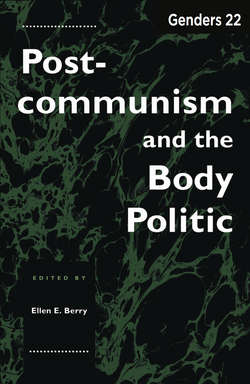Читать книгу Genders 22 - Ellen E. Berry - Страница 22
На сайте Литреса книга снята с продажи.
INTRODUCTION
ОглавлениеAs a woman from the “former Yugoslavia” who now lives in the United States, I am occasionally asked to speak about women in Yugoslavia. The request usually comes in the context of an interest in women of Eastern Europe, and has been, since the fall of the Eastern bloc, asked with an increased frequency. Whenever I am asked to speak about this topic, however, I experience unease which has little to do with the actual situation of women in Yugoslavia, and much more with the context and the assumptions within which this question is posed in American popular discourse. This unease has become so overwhelming that it has effectively blocked all my efforts to address the topic. In this essay, therefore, instead of talking about women in Yugoslavia, I explicate some of the reasons for my uneasiness with the request. This essay does not focus on specific traits and living conditions of women in Yugoslavia, but on some aspects of the context in which questions about specific characteristics of Yugoslavian women (and, more generally, East European women) are asked within American popular discourse. Out of a number of very complex political and scholarly issues that the topic raises I will here focus on three. The first concerns the implied nature of the “new” political and discursive space created out of the former first and second worlds. The second concerns the nature of cultural categories as studiable objects. The third concerns the need to partly rewrite current scholarly (and, perhaps, political) paradigms in order to effectively speak about the world today. The fall of the Eastern bloc can, among other things, be seen as a potential joining of what used to be two ostensibly different worlds (the first and the second) into a larger and more complex political and discursive space. This opens an interesting question: what is (going to be) the socio-cultural nature of this newly (re)created space? What is this new, “fircond,” world going to be like? The answer to this question is at issue whenever I am asked about women in Yugoslavia within the context of the Eastern bloc. And it is the assumptions about this space implied in the question that cause my unease. More specifically: (1) Yugoslavia is (re)positioned as an Eastern bloc country; and (2) to Yugoslavia is ascribed the difference and inferiority reserved in American popular discourse for an “other,” particularly for an other from the former “evil empire.” This indicates a distinctly American definition of the discursive space of the “fircond” world, since this particular positioning of Yugoslavia is an American one: the Eastern bloc frequently saw the country as Western, while by the rest of the world it was sometimes seen as third world, because of its nonaligned politics. In the first part of this essay, I discuss these issues by situating them in the context of two paradigms: cold-war and cultural diversity.
In the second part of the essay, I look at the question about women in Yugoslavia in the context of culturally constructed categories as studiable objects. Contemporary culture scholars tend to see all cultural categories as constructed. Seeing concepts such as Yugoslavian women and the Eastern Bloc as constructed rather than natural or self-evident might mean the “end of [American] innocence” with respect to the cold-war paradigm and the desire for genuine “cross-bloc” communication; it is this loss of belief in the givenness, the clear-cutness, the descriptive accuracy of the East/West Bloc division which might make it possible to realize that negotiating the space of the “fircond” world, theoretically at least, means redefinition of both of its constitutive discourses.
In the third part of the essay, I look at the question about women in Yugoslavia in the context of the contemporary multicultural, fractured, and multifaceted — and yet interdependent — world. How do we make sense of this world? It seems that nothing can be said about it, until everything is rewritten. I propose a new kind of cultural and theoretical frame to contemplate it within, the transcultural. I suggest that the transcultural can be conceived of in three ways: (1) as a complex, and/or heterogeneous space in which all other cultural categories are immersed, and out of which they are sometimes molded; (2) as an aspect of everybody’s culture, and, potentially, as a culture all its own: a culture of people with complex, transcultural experiences and affiliations; and (3) finally, as a mode of interaction which works well among groups and people aware and accepting of cultural difference but not prepared to let that difference permanently divide them. I conclude by briefly looking at the context in which this essay appears in the American discourse. I see this as an example of the transcultural interaction mode.
